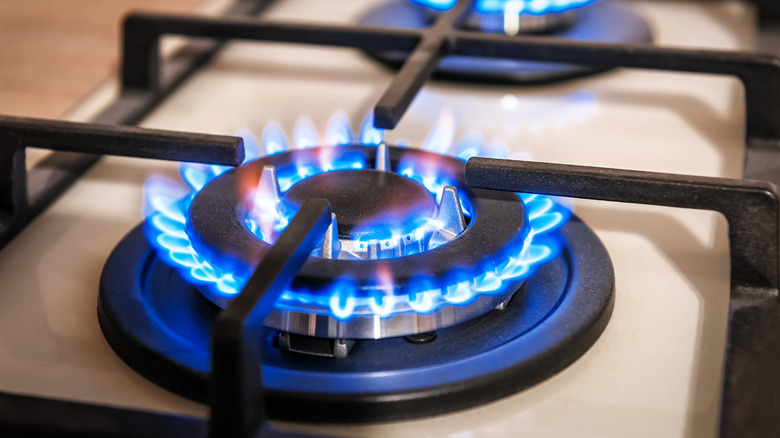Here's Why You May Want To Consider Getting Rid Of Your Gas Stove
Gas stoves have been a hot topic (pardon the pun) since earlier this year. The New York Times reported at the beginning of January, that the United States Consumer Product Safety Commission (CPSC) may look into the regulation of gas stoves in the future, due to growing scientific consensus that they pose a variety of health hazards. The ensuing news coverage and social media discussion around fears of government intervention led the CPSC chair, Alexander Hoehn-Saris, to announce that they are looking for ways to lessen the risk of poor indoor air quality that is related to the use of gas stoves.
Regardless of the political discussion around the issue, the important question is — are gas stoves safe? Potential health risks associated with gas stove use could be a pressing concern for a large number of Americans – Real Simple reports that in many U.S. states, over 50% of existing home cooking appliances use gas as a heat source. If you have a gas stove in your home and you use it for cooking regularly, you may be wondering if it's in your and your family's best interest to consider another cooking option.
The health risks of gas stoves
It's true that gas stoves can pose a hazard to human health when they are used for indoor cooking. According to the New York Times, gas stoves produce nitrous oxides, chemicals that the United States Environmental Protection Agency (EPA) regulates because of their poisonous and smog-producing capabilities. Frequent exposure to nitrous oxides has been linked to the development of asthma in children and an increased prevalence of asthma attacks in adults. People with other types of chronic respiratory conditions may also experience exacerbated health problems if they encounter nitrous oxides on a regular basis, such as through the use of gas stoves in a poorly ventilated indoor kitchen.
According to a 2022 study published in the research journal Environmental Science and Technology, worsened asthma attacks and coughing fits are not the only situation you have to worry about if you are using a gas stove in your home. Even for those without respiratory issues, researchers have found that the use of gas-powered cooking appliances in houses has been linked to the emission of carcinogens, which can lead to the development of cancer.
Gas stove alternatives
So, what other cooking options do you have? Your two main choices are an induction or an electric system, explains The New York Times. Induction appliances use magnetic waves for heating. Induction cooking has several advantages over conventional gas stoves, beyond the reduced health risk. Induction appliances heat up more quickly than gas or electric stoves, and because they apply heat directly to the bottom of a pan, heat is used more efficiently and effectively than gas (contrary to popular belief). In addition, the heat remains with the pan, not with the induction appliance itself, so there is much less risk of burning yourself.
However, induction appliances also have drawbacks. They can only be used with pans made of certain magnetic metals, due to their reliance on magnetism for heat, and they typically cost more than gas or electric stoves. Electric stoves, in contrast, use an electrical coil to heat up the pan. Because of the separation between the heat source and the pan, electric stoves are not as efficient as gas or induction models. But, they are cheaper and more widely available than induction models, and they are easier to clean than gas stoves.


